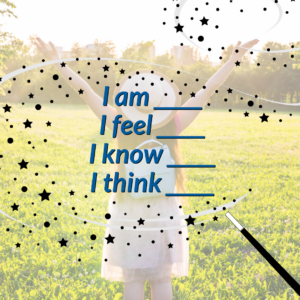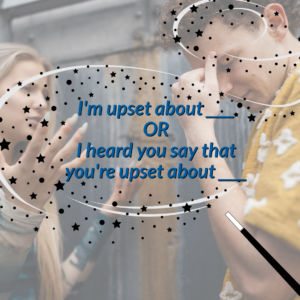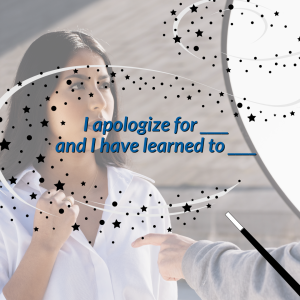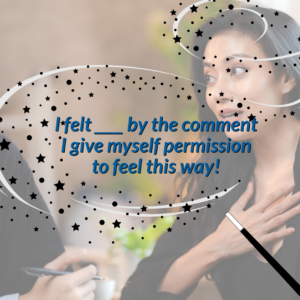GraceSOULutions COMMUNICATES Happily Ever After… [Importance of I]
// by Preston Test
In the seventh component of COMMUNICATES Happily Ever After, we’re going to explore is the Importance of “I.”
If you’re into reading or telling stories you know that main characters, protagonists, can sometimes give their power away to support characters, or companions by using words like “you.” This can take the form of statements such as ‘you chose to go this way’ or ‘you made me do this’ or even ‘we wouldn’t be in this position if you had or hadn’t done […]’ as they go through their journey.
In those instances, the protagonist gave away their power when they used the word ‘you’ and at that point they stated specifically that the companion did something directly to the main characters which isn’t entirely true.
That is just part of being human and having human experiences.
What can you do to bring back the power to you?
First you have to understand that when you make comments such as “you made me feel…” or “you could have…” you gave your power away to the other person by telling the person he or she did something to you.
No matter what the other person did or didn’t do, the truth is that you have control over your feelings, thoughts, emotions, behaviors, etc.
Bring your power back to you by using “I” Statements.
Magic phrases that will lead to happily ever after…

Magic phrases you can use are:
I am_______.
I feel_______.
I know_______.
I think _______.
When you use “I” statements you’re reclaiming control of what you’re feel, think, or believe about what happened.
There is no blame, and no blame on the other person. You’re clearly stating what you’re feeling and wanting so you now have your power back.
As a main character in your story, you can choose to give your power away or reclaim and stand in your power with I statements to your happily ever after.
A Magic Phrase For When It’s Not Funny | GraceSOULutions COMMUNICATES Happily Ever After
// by Preston Test
GraceSOULutions COMMUNICATES Happily Ever After… [Not Funny]
// by Preston Test
In the COMMUNICATES Happily Ever After, the sixth component we’re going to explore is Not Funny.
If you’re into reading or telling stories you know that the main characters can encounter some people who try to add humor to help lighten the mood or help bleak situations (comic relief characters). Sometimes the main characters are the ones who do their best to add humor to the situations as they go through their journey.
Encountering different people and situations isn’t always easy and so you, as the main character, will undoubtedly have situations where it might be you or someone else who wants to lighten up the mood, but does so in the wrong way with an inappropriate comment or poor timing.
That is just part of the human experience.
What do you do when the attempt to lighten up the mood goes all wrong?
You know the attempt to lighten up the mood or situation goes wrong when someone says something like, “That’s not funny” or “Oh, you think this is funny? Because I don’t.”
Magic phrases that will lead to happily ever after…

Magic phrase: That joke fell flat.
It’s that simple. When someone says something that is not funny or tries to be funny, but the joke didn’t work on you because, let’s say, it felt like the person was picking on you in a mean way. Then at that point you can simply say, “that joke fell flat.”
You’re not directing the phrase at the person, rather you’re directing it at the joke not being funny and it not working for you and therefore you’re not going to give a reaction.
If the person asks you why it isn’t funny or makes comments such as “you’re being too sensitive” or “you can’t take a joke,” simply repeat the phrase “that joke fell flat” and leave it at that.
As a main character in your story, you can choose what is funny or not to you and whether what was said was a joke or an insult.
You can choose to fight back with an insult of your own or instead you can use the magic phrase when something was said was not funny.
That will lead you toward your happily ever after.
If you’re an introverted, people pleaser, conflict-phobic person who would love to openly and confidently communicate your thoughts, feelings, and desires without the fear of arguments and criticisms so you can have your happily ever after, then click below to book your free Communication Breakthrough Session where we will discover 5 obstacles that are stopping you and One step to move you toward to living your happily ever after.
Warm regards,
Grace CW Liu
Communication Coach & Navigator
W: GraceSOULutions.com

A Magic Phrase For Feeling Upset | GraceSOULutions COMMUNICATES Happily Ever After
// by Preston Test
GraceSOULutions COMMUNICATES Happily Ever After… [Upset]
// by Preston Test
In this COMMUNICATES series just know you are the Main Character.
In COMMUNICATES Happily Ever After, the fifth component we’re going to explore is Upset.
If you’re into reading or telling stories you know that the main characters can encounter people or situations where the protagonists can become upset with a person, a group of people, or an entire situation. Sometimes it can be a person or a group of people who are upset with the main characters either because something didn’t go according to plan or because the protagonists do something to upset somebody as they go through their journey.
Encountering different people and situations isn’t always easy and so for you, as the main character of your own story you will undoubtedly either upset someone or someone or situation will upset you.
That is just part of being human and a part of the human experience.
What do you do when you’re upset? Or when someone upsets you when things don’t go according to plan or something was said that shouldn’t have been said that left someone feeling upset about the specific comment?
When a person is truly upset, speaking and acting irrationally avoid saying ‘calm down’.
Even though that is exactly what the person needs to do, saying ‘calm down’ will just set the person off even more. How can a person be calm when everything is falling apart.
Would you be able to remain calm if everything was falling apart and didn’t go according to plan or wasn’t what you wanted nor expected?
Magic phrases that will lead to happily ever after…

Magic phrase
(If you’re the one who is upset): I’m upset about______(be specific about what you’re upset about. If it was said, state the exact statement that upset you, if it was an action, state the exact action).
(If someone is upset with you): I heard you say that you’re upset about _______(repeat back the list of items that the person listed he or she was upset about. Use the person’s exact words or words that are close to what the person said). I’m sorry to hear that this happened. I would be upset as well. I will do my best to help find a solution for you.
The whole idea is to avoid blame. Avoid putting blame on yourself and others. Blaming doesn’t help to solve an issue; in fact, it just creates more problems and headaches. Rather than blaming, the focus is on finding ways to resolve issues and conflicts.
One of the ways to resolve the issue is to acknowledge that you and/or the person is upset and given each person has free will, meaning the right to feel what he or she is feeling, then the person has the right to feel upset even if you might disagree.
Whether you agree or disagree does not matter.
What matters is that you acknowledge the person who is upset because of the specific reasons that were given by that person and you show him or her you care by validating what the person said to you.
In return you want the person who hurt you to validate your feelings by repeating what you said so that you know you were seen, heard, and understood.
The truth is that when you’re upset or if someone is upset with you, you and/or the other person wants to be validated.
You validate someone by repeating back what the person said.
As a main character in your story, you don’t have to agree or disagree with the reason for someone being upset and likewise the person doesn’t have to agree or disagree with you when you’re the one who is upset. You can certainly choose to validate a person’s feeling or not.
Validating someone who is upset is an easier path that will lead you to your happily ever after.
If you’re an introverted, people pleaser, conflict-phobic person who would love to openly and confidently communicate your thoughts, feelings, and desires without the fear of arguments and criticisms so you can have your happily ever after, then click below to book your free Communication Breakthrough Session where we will discover 5 obstacles that are stopping you and One step to move you toward to living your happily ever after.
Warm regards,
Grace CW Liu
Communication Coach & Navigator
W: GraceSOULutions.com

A Magic Phrase For Mistakes | GraceSOULutions COMMUNICATES Happily Ever After
// by Preston Test
GraceSOULutions COMMUNICATES Happily Ever After… [Mistakes]
// by Preston Test
In this COMMUNICATES series you are the Main Character!
In COMMUNICATES Happily Ever After, the fourth component we’re going to explore is Mistake.
If you’re into reading or telling stories, you know that the main characters can encounter people or situations where they are being blamed for a mistake that occurred as they go through their journeys.
Encountering different people and situations isn’t always easy and so for you, as the main character you will undoubtedly encounter a situation where you are blamed for a mistake or something that occurred either by you or by someone else.
That is just a natural part of the human experience.
What do you do when you come across a situation where you blame yourself, blame others, or you’re being blamed for something?
Someone might say something like this to you: “This is your fault” or “This wouldn’t have happened if you had or hadn’t done [x,y,z…]”.
What is a good way to respond when someone makes those comments to you?
Here is a Magic Phrase that will lead to happily ever after…

Magic phrase: I apologize for _______[state the mistake, take ownership of the mistake that was made by you and not by other people] and I have learned to do_______[state the solution that you learned from the mistake] or I am going to change _____[state the specific changes you are going to make].
This magic phrase shows that you are willing to take ownership of your mistake. Be courageous and face it so a solution can be found and made rather than hiding from it and making it worse.
It shows that you are willing to change or make the necessary adjustments to improve your situation rather than keeping things at the status quo.
It’s okay to make mistakes! That’s how we learn. So take ownership, learn from it, and make the changes that will help solve the situation.
As the main character in your own story, you can choose to take ownership of your mistakes or not. Whatever you choose to do, there are consequences and results from each choice you make. Just make sure that whatever in whatever you choose that you choose wisely.
You are permitted to make mistakes and you will make many. After all, that is how you learn. Solutions are usually found after a mistake has been made. Mistakes aren’t the issues, the issues lie in how you treat your mistakes. If you treat them in a better way, this will lead you to your happily ever after.
If you’re an introverted, people pleaser, conflict-phobic person who would love to openly and confidently communicate your thoughts, feelings, and desires without the fear of arguments and criticisms so you can have your happily ever after, then click below to book your free Communication Breakthrough Session where we will discover 5 obstacles that are stopping you and One step to move you toward to living your happily ever after.
Warm regards,
Grace CW Liu
Communication Coach & Navigator
W: GraceSOULutions.com

A Magic Phrase For Moodiness | GraceSOULutions COMMUNICATES Happily Ever After
// by Preston Test
GraceSOULutions COMMUNICATES Happily Ever After… [Moody]
// by Preston Test
In this COMMUNICATES series just know you are the Main Character.
In the COMMUNICATES Happily Ever After, the third component we’re going to explore is Mood or Moody.
If you’re into reading or telling stories you know that the main characters can encounter different people with different moods and the main characters can also experience moodiness in themselves as they go through their journey.
Encountering different people and situations aren’t always easy and so you, as the main character will at times feel the different moods and becoming moody at times or come across people who are moody.
That is just part of being human and having human experiences.
What do you do when you come across moody people or when you’re the one who is moody?
Someone might say something like, “You’re overreacting” or “You’re (being) too sensitive”.
What is a way to respond or say when someone makes those comments to you?
Magic phrases that will lead to happily ever after…

Magic phrase: I (do) feel or felt _______(state your feeling) by the comment. I’m permitted to feel this way or I give myself permission to feel this way.
There is no blame and it’s good to state how you’re feeling by the comment because you’re stating the truth that you’re feeling.
Give yourself permission to feel and state your feelings.
Maybe you did overreact, or you were being sensitive, and that’s okay because you’re allowed to have those feelings. You are allowed to feel whatever it is your feeling.
It’s just feelings and feelings come and go, so notice your feelings, acknowledge it and know that there really isn’t a good or bad feelings even though we as humans have labeled some feelings as good and bad.
We all have had good and bad feelings, and if we’re being totally honest with ourselves those feelings can just come and go as the tides ebb and flow.
As a main character in your story, you can choose not to take the comments personally. The person making the comment is just making a comment even though it appears to be directed towards you, it’s not about you. A person speaking could be reflecting the statement back at him or her. The moodiness of the statement could be a reflection of how the other person is feeling.
You are permitted to feel your feelings and state your feelings to the person that will lead you to your happily ever after.
If you’re an introverted, people pleaser, conflict-phobic person who would love to openly and confidently communicate your thoughts, feelings, and desires without the fear of arguments and criticisms so you can have your happily ever after, then click below to book your free Communication Breakthrough Session where we will discover 5 obstacles that are stopping you and One step to move you toward to living your happily ever after.
Warm regards,
Grace CW Liu
Communication Coach & Navigator
W: GraceSOULutions.com

- Page 1
- Page 2
- Page 3
- Interim pages omitted …
- Page 11
- Go to Next Page »
